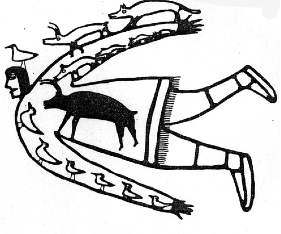The Arctic Shaman:
What role did they serve in their community?
|
|

The
Arctic
shaman, known as angakoq, served a vital role in their
community as healers,
spiritual guides, and mediums of information from the
incomprehensible realms
of the spirit
world to the
Picturesque frozen landscape of the arctic. This pathfinder
serves as a
bibliographic guidebook that will illuminate the pathway for
the inspired
reader who may find themselves in the midst of a deeper
interest for the
subject in order that they may dive into this paper's original
resources of
information.
(Primary
resources)
1. RAsmussen, Knud.Across
Arctic America: Narrative of the Fifth Thule
Expedition.
Fairbanks, AK: U of Alaska, 1999. Print.
This
book
was by far my primary resource for writing this paper. a
greenlander Part
eskimo knud rasmussen travels to the lands of the artic with a
thirst to learn
and connect with the eskimo people. He lives with them, eats
with them, and
opens himself to all aspects of their culture as he documents
it every step of
the way. A great read that is chocked full of valuable
information about the
arctic shamans. Knud encounters many different angakoqs on his
journey and sees
firsthand the many ways in which they serve their community.
2.
RAsmussen,
Knud.The netsilik eskimos:
social life
and spiritual culture.
Copenhagen: gyldendalske
boghandel, nordisk forlag,
1931. Print.
This too is another one of knud's
accounts. As in the
first one, detailed firsthand accounts are orated by various
shaman. We learn
of orpingalik the shaman who is also a poet and considers his
songs to be
“comrades in solitude.” we also learn about the importance of
amulets and the
way in which a shaman may prescribe them to the recipients of
his treatment
plan.
3. Gould, Sydney. "The Innuit." Ed. John West and Bishop G.J. Mountain. Inasmuch; Sketches of the Beginnings of the Church of England in Canada in Relation to the Indian and Eskimo Races. Toronto: n.p., 1917. The Newberry LIbrary Catalogue. The Edward E. Ayer Collection. Web. 27 Mar. 2017.
This resource provided a brief and well-rounded summary of inuit culture. An introduction of the angakoq is presented, alongside a description of the inuit people's spiritual beliefs and practices. The importance of taboos are mentioned. The derisive form of eskimo is described. The importance of the angakoq's connection with the spirit realm is expressed.
4.
Jackson,
Sheldon, Rev. Alaska, and Missions on the North Pacific Coast.
New
York: Dodd,
Mead, 1880. 97+. The Newberry LIbrary Catalogue. The Edward
E.
Ayer Collection. Web. 27 Mar. 2017.
“Alaska” provided a first hand account of Alaskan natives from the perspective of a christian Reverend in 1880. the content of this book supported the content of the paper with descriptions of the practice of calling upon spirit helpers by shaman, the use of drums and rattles to induce trance, alongside religious fasting, and various healing rituals. Though the information was a detailed account, it was written from a heavily close-minded christian point of view.
(Secondary resources)
5. Bancroft-Hunt, Norman. "The Half-World of the Eskimo Aleut." Shamanism in North America. Buffalo, NY: Firefly, 2003. N. pag. Print.
This book was the impetus for my inspiration to write about this subject. I discovered the book at the austin public library and it just so happened that the first chapter was about shamanism of the eskimo-aleut. I became deeply intrigued and decided to dedicate my paper to the subject. Norman Bancroft hunt writes from a place of deep experience as if he is really there and knows the shaman on an intimate level. His stories spoke of the animal spirit forces called tunghat. He describes the out of body experience that a shaman goes through and the purpose this serves. He also speaks of the spirit's mischievous nature and how the shaman must be utterly skillful in order to maintain not being taken advantage of by them.
6.shamanism
and
spirit. Expedition Spring 46.1 (2004): 12-15. Ebsco. Web. 27
Mar.
2017.
This
is an
article that describes the origin of the word shaman and a
description of
shamanic experiences related to going out of body and
experiencing
hallucinations, as well as healing accounts. This was a
resource that was not
heavily relied on for my article, yet it backed up the
information obtained
from my primary resources.
7. Wissler, Clark. The American Indian. New York: McMurtrie, Douglas C., 1917. 188-91. The Newberry Library Catalogue. The Edward E. Ayer Collection. Web. 27 Mar. 2017.
This
excerpt from “The american indian”
briefly mentions the angakoq amongst a few sentences
scattered
throughout. This
resource zooms
out into a
kaleidoscope view of
various shamanic cultures. “The american indian,” though
considered to be of
primary source status, truly served to build my knowledge base
about shamanism
in general.
This Pathfinder was developed by Austin Community College Honors Student: Silver Spirit